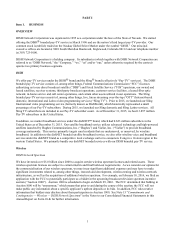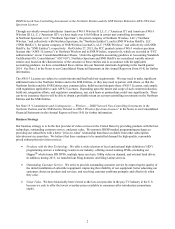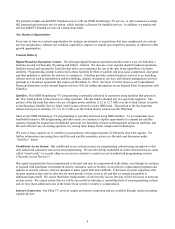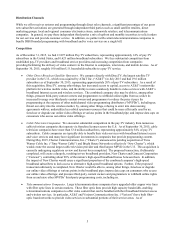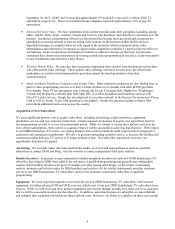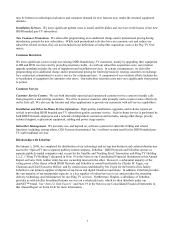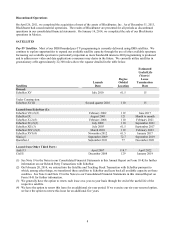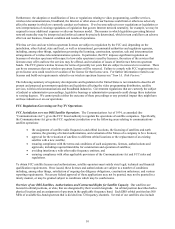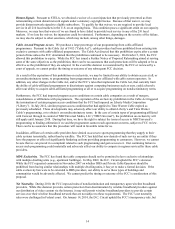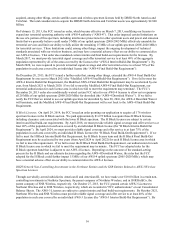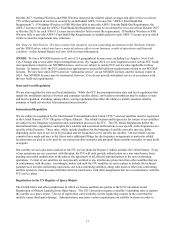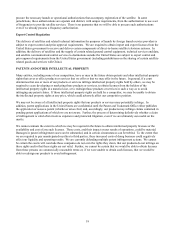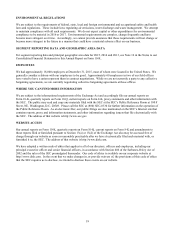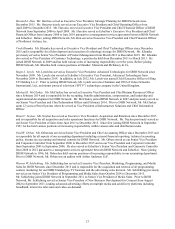Dish Network 2015 Annual Report Download - page 21
Download and view the complete annual report
Please find page 21 of the 2015 Dish Network annual report below. You can navigate through the pages in the report by either clicking on the pages listed below, or by using the keyword search tool below to find specific information within the annual report.11
spot-beam technology that enables us to increase the number of markets where we provide local channels, but reduces
the number of video channels that could otherwise be offered across the entire United States.
The FCC has licensed us to operate a total of 50 DBS frequency channels at the following orbital locations:
x 21 DBS frequency channels at the 119 degree orbital location, capable of providing service to the
continental United States (“CONUS”); and
x 29 DBS frequency channels at the 110 degree orbital location, capable of providing service to CONUS.
In addition, we currently lease or have entered into agreements to lease capacity on satellites using the following
spectrum at the following orbital locations:
x 500 MHz of Ku-band FSS spectrum that is divided into 32 frequency channels at the 118.7 degree orbital
location, which is a Canadian FSS slot that is capable of providing service to CONUS, Alaska and Hawaii;
x 32 DBS frequency channels at the 129 degree orbital location, which is a Canadian DBS slot that is capable
of providing service to most of the United States;
x 32 DBS frequency channels at the 61.5 degree orbital location, capable of providing service to most of the
United States;
x 24 DBS frequency channels at the 77 degree orbital location, which is a Mexican DBS slot that is capable
of providing service to most of the United States and Mexico; and
x 32 DBS frequency channels at the 72.7 degree orbital location, which is a Canadian DBS slot that is
capable of providing service to CONUS.
We also have month-to-month FSS capacity available from EchoStar on a satellite located at the 121 degree orbital
location and a lease for FSS capacity available from EchoStar on a satellite located at the 103 degree orbital location.
In June 2015, the FCC granted us authority to provide service to the United States from a Canadian-licensed satellite
using Reverse Band Working DBS frequencies at the 103 degree orbital location.
Duration of our DBS Satellite Licenses. Generally speaking, all of our satellite licenses are subject to expiration unless
renewed by the FCC. The term of each of our DBS licenses is ten years. Our licenses are currently set to expire at
various times. In addition, at various times we have relied on special temporary authorizations for our operations. A
special temporary authorization is granted for a period of only 180 days or less, subject again to possible renewal by the
FCC. From time to time, we apply for authorizations to use new satellites at our existing orbital locations. For example,
in October 2014, we filed an application with the FCC to launch and operate a new satellite, EchoStar XVIII, at the 110
degree orbital location, which was granted in March 2015. Generally, our FCC licenses and special temporary
authorizations have been renewed, and our applications for new satellites at our existing orbital locations have been
approved, by the FCC on a routine basis, but there can be no assurance that the FCC will continue to do so.
Opposition and Other Risks to our Licenses. Several third parties have opposed in the past, and we expect these or
other parties to oppose in the future, some of our FCC satellite authorizations and pending and future requests to the FCC
for extensions, modifications, waivers and approvals of our licenses. In addition, we must comply with numerous FCC
reporting, filing and other requirements in connection with our satellite authorizations. Consequently, it is possible the
FCC could revoke, terminate, condition or decline to extend or renew certain of our authorizations or licenses.
4.5 Degree Spacing “Tweener” Satellites. The FCC has proposed to allow so-called “tweener” DBS operations — DBS
satellites operating at orbital locations 4.5 degrees (half of the usual nine degrees) away from other DBS satellites. The
FCC granted authorizations to EchoStar and Spectrum Five for tweener satellites at the 86.5 and 114.5 degree orbital
locations, respectively. These authorizations were subsequently cancelled because the FCC determined that the licensees
did not meet certain milestone requirements. Tweener operations close to our licensed orbital locations could cause
harmful interference to our service and constrain our future operations. The FCC has not completed its rulemaking on
the operating and service rules for tweener satellites.


